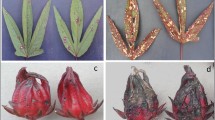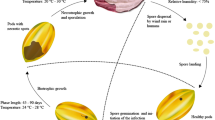Abstract
The main cotton growing regions in South America are affected by Colletotrichum gossypii var. cephalosporioides (Cgc). The most severe epidemics provoke considerable yield reductions linked to meristem necrosis, over-sprouting, branching and stunting. The Sinú Valley is the greatest cotton producer in Colombia and is heavily affected by this disease. Using data from field trials conducted in 2012, 2013 and 2014 in a naturally infested area covering 15 planting dates, we attempted to identify weather variables linked to ramulosis epidemics. Cotton planting season in the Sinú Valley runs from August to November, with higher rainfall intensity and frequency for crops planted earlier at the season while decreasing as the meridional winter solstice is approached. Rainfall, temperature and RH variables were significantly correlated with disease development (measured as AUDPS for ramulosis infection intensity). Rainfall alone was able to explain the majority of variation in ramulosis development across all the testing planting dates. A linear regression model was fitted for this association between ramulosis development and accumulated rainfall. Disease development is higher in the early planting dates (mid-August to September) while the disease is absent in crops established at October.





Similar content being viewed by others
References
Araújo, A. E., & Suassuna, N. D. (2008). Metodologia de avaliação da ramulose do algodoeiro visando a seleção para resistência à doença. Comunicado Técnico: Embrapa Algodão http://ainfo.cnptia.embrapa.br/digital/bitstream/CNPA-2009-09/22321/1/COMTEC352.pdf. Accessed 11 Nov 2014.
Araújo, A. E., Suassuna, N. D., Freitas, J. S., & Farias, F. J. C. (2003). Escala de notas para avaliação de doenças foliares do algodoeiro. In Congresso Brasileiro de Algodão, Embrapa Algodão, Campina Grande, Brazil (pp. 1–7).
Bailey, J. A., Nash, C., Morgan, L. W., O’connell, R. J., & TeBeest, D. O. (1996). Molecular taxonomy of Colletotrichum species causing anthracnose on the Malvaceae. Phytopathology, 86(10), 1076–1083.
Costa, A. S., & Fraga Júnior, C. G. (1939). Sobre a natureza da ramulose ou superbrotamento do algodoeiro. Jornal de Agronomia, 2(4), 151–160.
Czermainski, A. B. C. (1999). Generalização de um índice de intensidade de infecção em experimentos de avaliação de doenças em plantas. Pesquisa Agropecuária Brasileira, 34(9), 1545–1555.
Fitt, B. D., McCartney, H. A., & Walklate, P. J. (1989). The role of rain in dispersal of pathogen inoculum. Annual Review of Phytopathology, 27(1), 241–270.
Gilet, T., & Bourouiba, L. (2014). Rain-induced ejection of pathogens from leaves: Revisiting the hypothesis of splash-on-film using high-speed visualization. Integrative and Comparative Biology, 54(6), 974–984.
Gilet, T., & Bourouiba, L. (2015). Fluid fragmentation shapes rain-induced foliar disease transmission. Journal of the Royal Society Interface, 12(104), 20141092.
Huber, L., Madden, L. V., & Fitt, B. D. (2006). Environmental biophysics applied to the dispersal of fungal spores by rain-splash. In B. M. Cooke, D. Gareth Jones, & B. Kaye (Eds.), The epidemiology of plant diseases (pp. 417–444). New York: Springer.
Madden, L. V. (1992). Rainfall and the dispersal of fungal spores. Advances in Plant Pathology, 8, 39–79.
Madden, L. V., Yang, X., & Wilson, L. L. (1996). Effects of rain intensity on splash dispersal of Colletotrichum acutatum. Phytopathology, 86(8), 864–874.
Malaguti, G. (1955). La escobilla del algodón en Venezuela. Agronomia Tropical, 5(2), 73–86.
Mathieson, J. T., & Mangano, V. (1985). Ramulose, a new cotton disease in Paraguay caused by Colletotrichum gossypii var. cephalosporioides. Summa Phytopathologica, 11(1/2), 115–118.
Mesa, S., Poveda, O. J., & G Carvajal, L. (1997). Introducción al clima de Colombia. Bogota: Universidad Nacional de Colombia.
Monteiro, J. E. B., Sentelhas, P. C., Gleason, M. L., Esker, P. D., & Chiavegato, E. J. (2009). Development of ramulosis disease of cotton under controlled environment and field conditions. Phytopathology, 99(6), 659–665.
Moreno-Moran, M., & Burbano-Figueroa, O. (2016). First report of Colletotrichum gossypii var. cephalosporioides causing cotton ramulosis in Colombia. Plant Disease, 100(3), 653.
Mouen Bedimo, J. A., Bieysse, D., Cilas, C., & Nottéghem, J. L. (2007). Spatio-temporal dynamics of arabica coffee berry disease caused by Colletotrichum kahawae on a plot scale. Plant Disease, 91(10), 1229–1236.
Mouen Bedimo, J. A., Bieysse, D., Nyassé, S., Nottéghem, J. L., & Cilas, C. (2010). Role of rainfall in the development of coffee berry disease in Coffea arabica caused by Colletotrichum kahawae, in Cameroon. Plant Pathology, 59(2), 324–329.
do Nascimento, J. F., Zambolim, L., do Vale, F. X. R., Berger, P. G., & Cecon, P. R. (2006). Cotton resistance to ramulose and variability of Colletotrichum gossypii f. Sp. cephalosporioides. Summa Phytopathologica, 32(1), 9–15.
Ntahimpera, N., Wilson, L. L., Ellis, M. A., & Madden, L. V. (1999). Comparison of rain effects on splash dispersal of three Colletotrichum species infecting strawberry. Phytopathology, 89(7), 555–563.
Oliveira, M. A. C., Duarte, J. B., de Morello, C. L., Suassuna, N. D., & Oliveira, A. B. (2010). Inheritance of resistance to Colletotrichum gossypii var. cephalosporioides in cotton. Crop Breeding and Applied Biotechnology, 10(1), 65–73.
Palencia Severiche, G., Mercado Fernández, T., Combatt Caballero, E., Martino, D. L., de Osuna Canizalez, F. J., & Machado, A. A. (2006). Estudio Agroclimático del Departamento de Córdoba. Montería: Universidad de Córdoba – Graficas del Caribe.
Peel, M. C., Finlayson, B. L., & McMahon, T. A. (2007). Updated world map of the Köppen-Geiger climate classification. Hydrology and Earth System Sciences, 11(5), 1633–1644.
Penet, L., Guyader, S., Pétro, D., Salles, M., & Bussière, F. (2014). Direct splash dispersal prevails over indirect and subsequent spread during rains in Colletotrichum gloeosporioides infecting yams. PloS One, 9(12), e115757.
Peres, N. A., Timmer, L. W., Adaskaveg, J. E., & Correll, J. C. (2005). Lifestyles of Colletotrichum acutatum. Plant Disease, 89(8), 784–796.
Poveda, G. (2004). La hidroclimatología de Colombia: una síntesis desde la escala inter-decadal hasta la escala diurna. Revista de la Academia Colombiana de Ciencias, 28(107), 201–222.
Restrepo, J. C., Ortíz, J. C., Maza, M., Otero, L., Alvarado, M., & Aguirre, J. (2012). Estimating fluvial discharge in the Caribbean seaboard of Colombia: Magnitude, variability and extreme events. Coastal Engineering Proceedings, 1(33), 44.
Salustiano, M. E., Rondon, M. N., Abreu, L. M., da Silva Costa, S., da Cruz Machado, J., & Pfenning, L. H. (2014). The etiological agent of cotton ramulosis represents a single phylogenetic lineage within the Colletotrichum gloeosporioides species complex. Tropical Plant Pathology, 39(5), 357–367.
Saran, P. E. (2009). Manual de identificação de doenças do algodoeiro. FMC Agricultural Products. http://www.fmcdireto.com.br/portal/manuais/doencas_algodoeiro/index.html. Accessed 24 May 2015.
Silva-Mann, R., Salgado, K. C., Vieira, M., & Machado, J. C. (2002). Variabilidade genética de isolados do complexo Colletotrichum associados a sementes de algodoeiro, por meio de técnicas moleculares e inoculação em plantas. Fitopatologia Brasileira, 27(1), 27–32.
Silva-Mann, R., Filho, J. R. B., Mann, E. N., Vieira, M., da Cruz Machado, J., da Fonseca Santos, M., & de Jesus Boari, A. (2007). Instability of ramulosis reaction of cotton cultivars with respect to crop protection and registration procedures. Crop Breeding and Applied Technology, 7(4), 367–372.
Simko, I., & Piepho, H. P. (2012). The area under the disease progress stairs: Calculation, advantage, and application. Phytopathology, 102(4), 381–389.
Weir, B. S., Johnston, P. R., & Damm, U. (2012). The Colletotrichum gloeosporioides species complex. Studies in Mycology, 73(1), 115–180.
Yang, X. B., & TeBeest, D. O. (1992). Rain dispersal of Colletotrichum gloeosporioides in simulated rice field conditions. Phytopathology, 82(10), 1219–1222.
Acknowledgements
This research was funded by the Colombian Ministry of Agriculture and Rural Development (MADR) and Corporación Colombiana de Investigación Agropecuaria (CORPOICA) (Projects C04849 1211111008180820 and MADR 115 – CORPOICA 1828 C05773).
Author information
Authors and Affiliations
Corresponding author
Rights and permissions
About this article
Cite this article
Moreno-Moran, M., Burbano-Figueroa, O. Dynamics of cotton ramulosis epidemics caused by Colletotrichum gossypii var. cephalosporioides in Colombia. Eur J Plant Pathol 149, 443–454 (2017). https://doi.org/10.1007/s10658-017-1194-9
Accepted:
Published:
Issue Date:
DOI: https://doi.org/10.1007/s10658-017-1194-9




